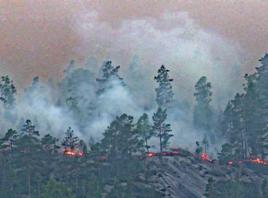April 14, 2014
Fujitsu Research & Development Center Co., Ltd. (Note 1(1)) has developed an automatic fire/smoke detection technology for forest monitoring. It can detect smoke and fire efficiently and in real time, and give alarm when the forest fire in its early stage.
Compared with existing products, our technology has a high detection ratio and low miss ratio. Some simple and efficient techniques are used to remove non-smoke objects from using motion detection. Moreover, we use image defogging and low light enhancement to make it robust in bad weather and low light environments. The algorithm is simple to make real time implementation possible with full HD video.
【Background】
China is a big area country and has huge forests, so there is massive damage due to forest fire each year. A good way to limit damage is to alarm and extinguish fire in its early stages. Automatic detection of fire and smoke through surveillance camera is a damage limiting method with low cost and high efficiency. And it can be used 24 hours a day.
In existing automatic fire/smoke detection products, the miss and false detection ratios are high. They commonly cannot distinguish between fog and smoke, and detect other objects as fire/smoke. To increase the efficiency of fire/smoke detection, we first enhanced the camera image with enhancement methods such as defogging and low light enhancement, and then removed non-fire/smoke objects by simple and efficient techniques.
【Topics】
The following problems exist in traditional methods, which have high false and miss detection ratios.
1) Cannot distinguish between fog and smoke. Heavy fog often occurs in forests at long distances. When smoke mixes with fog, traditional methods cannot tell the difference and this causes miss or false detection.
2) Cannot remove non-fire/smoke objects simply and efficiently. Non-fire/smoke objects are birds, animals, people, cars, cloud, vibrating trees, grass, and water reflection, etc. Traditional methods often detect these objects as fire/smoke.
Therefore, we developed a highly efficient technology for fire/smoke detection, which works robustly in fog and low light environments, and removes non-fire/smoke objects with high detection ratio.
【Technology】
Our fire/smoke detection technology consists of following steps: image sharpening, moving region detection, feature extraction, and classifier, as shown in Figure 1. In the image sharpening step, we use image defogging and low light enhancement for fog and low light conditions, respectively. In the feature extraction step, we use smoke color analysis, rising/growing region analysis, and smoke region analysis as features to remove non-fire/smoke objects.

Figure 1 Fire/smoke detection procedure
Heavy fog often occurs in wild forests. The fog and smoke are mixed and causes miss and false detection. The image defogging technology can detect the difference between them, as shown in Figure 2.
|
|
|
| Figure 2 Detecting difference between fog and smoke using defogging technology |
To implement the smoke detection feature simply and efficiently, we analyze the smoke region, as shown in Figure 3. The mass center is defined as the sum of the multiplication of pixels in some region (p=1) and its coordinates, and the geometry center is defined as the center of the bounding box. The mass center of the smoke often occurs at left, above, and right side of the geometry center (as directions 1, 2, 3, 4, and 5 in Figure 3).

Figure 3 Smoke region shape detection
We assume the mass center of the last frame is Mp(Xp,Yp) , and the mass center of the current frame is Mc (Xc,Yc). Then the difference is calculated as △X=Xc-Xp,△Y=Yc-Y p . When they meet with the directions of 1, 2, 3, 4, and 5 in Figure 3, we judge the region as smoke. We call this the rising/growing feature of smoke. This technique makes the algorithm simple and makes it possible to implement the software in real time with full HD video.
【Result】
(1) Fire/smoke detection ratio: >98%, miss ratio: <0.5%.
(2) Real time processing with SW, 30fps@1920x1080 (Intel Xeon 3.2GHz, 4GB memory).
(3) Defogging and fire/smoke detection result is shown in Figure 4, and the low light enhancement and fire detection is shown in Figure 5.
|
|
|
| Figure 4 Defogging and fire/smoke detection result |
|
|
|
| Figure 5 Low light enhancement and fire detection result |
【Future Plans】
In 2014, we will do field tests in forest monitoring with this technology, and improve the detection ratio. After some successful applications are achieved, we will promote it both in China and world-wide. For the implementation, the technology can be software running on servers in the surveillance system to process single or multiple ways of video. We can also embed it in image processors at the surveillance camera side.
![]() Phone: +86-21-6335-0606
Phone: +86-21-6335-0606![]() E-mail: defogging@cn.fujitsu.com
E-mail: defogging@cn.fujitsu.com






